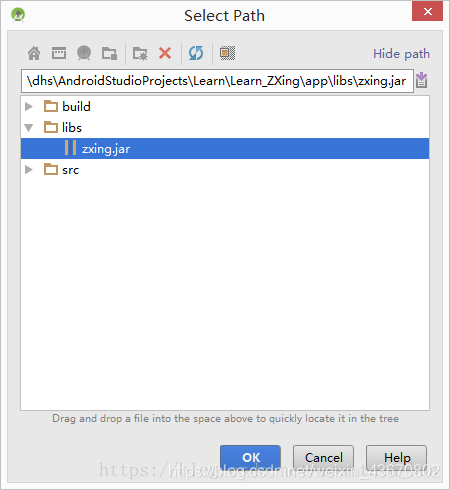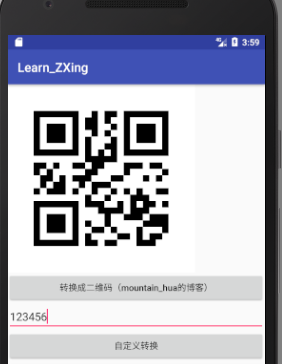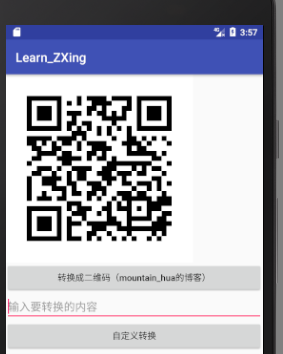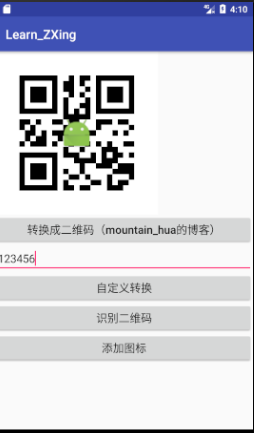感谢大佬:https://blog.csdn.net/mountain_hua/article/details/80646089
**gayhub上的zxing可用于生成二维码,识别二维码
gayhub地址:https://github.com/zxing/zxing
此文只是简易教程,文末附有完整代码和demo下载地址,进入正题:
(1)下载并导入zxing.jar包
下载:
zxing.jar下载地址,只需要1积分,方便大家学习下载。
把下载好的zxing.jar放在app的libs文件夹内,如图**

导入:
进入project structure.如图

点进去之后,依次进入app——Dependencies——jar dependency:

选择zxing.jar,导入

(2)生成二维码:
生成二维码的函数:
public void createQRcodeImage(String url)
{
im1=(ImageView)findViewById(R.id.imageView);
w=im1.getWidth();
h=im1.getHeight();
try
{
//判断URL合法性
if (url == null || "".equals(url) || url.length() < 1)
{
return;
}
Hashtable<EncodeHintType, String> hints = new Hashtable<EncodeHintType, String>();
hints.put(EncodeHintType.CHARACTER_SET, "utf-8");
//图像数据转换,使用了矩阵转换
BitMatrix bitMatrix = new QRCodeWriter().encode(url, BarcodeFormat.QR_CODE, w, h, hints);
int[] pixels = new int[w * h];
//下面这里按照二维码的算法,逐个生成二维码的图片,
//两个for循环是图片横列扫描的结果
for (int y = 0; y < h; y++)
{
for (int x = 0; x < w; x++)
{
if (bitMatrix.get(x, y))
{
pixels[y * w + x] = 0xff000000;
}
else
{
pixels[y * w + x] = 0xffffffff;
}
}
}
//生成二维码图片的格式,使用ARGB_8888
Bitmap bitmap = Bitmap.createBitmap(w, h, Bitmap.Config.ARGB_8888);
bitmap.setPixels(pixels, 0, w, 0, 0, w, h);
//显示到我们的ImageView上面
im1.setImageBitmap(bitmap);
}
catch (WriterException e)
{
e.printStackTrace();
}
}
设置两种转换方式,默认转换/自定义转换:
Button bt=(Button)findViewById(R.id.button);
bt.setOnClickListener(new View.OnClickListener() {
@Override
public void onClick(View v) {
createQRcodeImage("https://blog.csdn.net/mountain_hua");//url为我的csdn博客地址
}
});
Button bt2=(Button)findViewById(R.id.button2);
bt2.setOnClickListener(new View.OnClickListener() {
@Override
public void onClick(View v) {
EditText editText=(EditText)findViewById(R.id.editText);
createQRcodeImage(editText.getText().toString());//自定义转换内容
}
});
默认转换为我的博客: 自定义转换:


(3)识别二维码
识别二维码需要一个RGBLuminanceSource类:
//识别图片所需要的RGBLuminanceSource类
public class RGBLuminanceSource extends LuminanceSource {
private byte bitmapPixels[];
protected RGBLuminanceSource(Bitmap bitmap) {
super(bitmap.getWidth(), bitmap.getHeight());
// 首先,要取得该图片的像素数组内容
int[] data = new int[bitmap.getWidth() * bitmap.getHeight()];
this.bitmapPixels = new byte[bitmap.getWidth() * bitmap.getHeight()];
bitmap.getPixels(data, 0, getWidth(), 0, 0, getWidth(), getHeight());
// 将int数组转换为byte数组,也就是取像素值中蓝色值部分作为辨析内容
for (int i = 0; i < data.length; i++) {
this.bitmapPixels[i] = (byte) data[i];
}
}
@Override
public byte[] getMatrix() {
// 返回我们生成好的像素数据
return bitmapPixels;
}
@Override
public byte[] getRow(int y, byte[] row) {
// 这里要得到指定行的像素数据
System.arraycopy(bitmapPixels, y * getWidth(), row, 0, getWidth());
return row;
}
}
识别二维码的函数:
//识别二维码的函数
public void recogQRcode(ImageView imageView){
Bitmap QRbmp = ((BitmapDrawable) (imageView).getDrawable()).getBitmap(); //将图片bitmap化
int width = QRbmp.getWidth();
int height = QRbmp.getHeight();
int[] data = new int[width * height];
QRbmp.getPixels(data, 0, width, 0, 0, width, height); //得到像素
RGBLuminanceSource source = new RGBLuminanceSource(QRbmp); //RGBLuminanceSource对象
BinaryBitmap bitmap1 = new BinaryBitmap(new HybridBinarizer(source));
QRCodeReader reader = new QRCodeReader();
Result re = null;
try {
//得到结果
re = reader.decode(bitmap1);
} catch (NotFoundException e) {
e.printStackTrace();
} catch (ChecksumException e) {
e.printStackTrace();
} catch (FormatException e) {
e.printStackTrace();
}
//Toast出内容
Toast.makeText(MainActivity.this,re.getText(),Toast.LENGTH_SHORT).show();
//利用正则表达式判断内容是否是URL,是的话则打开网页
String regex = "(((https|http)?://)?([a-z0-9]+[.])|(www.))"
+ "\w+[.|\/]([a-z0-9]{0,})?[[.]([a-z0-9]{0,})]+((/[\S&&[^,;u4E00-u9FA5]]+)+)?([.][a-z0-9]{0,}+|/?)";//设置正则表达式
Pattern pat = Pattern.compile(regex.trim());//比对
Matcher mat = pat.matcher(re.getText().trim());
if (mat.matches()){
Uri uri = Uri.parse(re.getText());
Intent intent = new Intent(Intent.ACTION_VIEW, uri);//打开浏览器
startActivity(intent);
}
}
下面看识别效果:
这是识别URL的结果: 这是识别一般文字的结果:


(4)完整代码:
Mainactivity:
package mountain_hua.learn_zxing;
import android.content.Intent;
import android.graphics.Bitmap;
import android.graphics.drawable.BitmapDrawable;
import android.net.Uri;
import android.support.v7.app.AppCompatActivity;
import android.os.Bundle;
import android.view.View;
import android.widget.Button;
import android.widget.EditText;
import android.widget.ImageView;
import android.widget.Toast;
import com.google.zxing.BarcodeFormat;
import com.google.zxing.BinaryBitmap;
import com.google.zxing.ChecksumException;
import com.google.zxing.EncodeHintType;
import com.google.zxing.FormatException;
import com.google.zxing.LuminanceSource;
import com.google.zxing.NotFoundException;
import com.google.zxing.Result;
import com.google.zxing.WriterException;
import com.google.zxing.common.BitMatrix;
import com.google.zxing.common.HybridBinarizer;
import com.google.zxing.qrcode.QRCodeReader;
import com.google.zxing.qrcode.QRCodeWriter;
import java.util.Hashtable;
import java.util.regex.Matcher;
import java.util.regex.Pattern;
public class MainActivity extends AppCompatActivity {
private ImageView im1; //imageview图片
private int w,h; //图片宽度w,高度h
@Override
protected void onCreate(Bundle savedInstanceState) {
super.onCreate(savedInstanceState);
setContentView(R.layout.activity_main);
Button bt=(Button)findViewById(R.id.button);
bt.setOnClickListener(new View.OnClickListener() {
@Override
public void onClick(View v) {
createQRcodeImage("https://blog.csdn.net/mountain_hua");//url为我的csdn博客地址
}
});
Button bt2=(Button)findViewById(R.id.button2);
bt2.setOnClickListener(new View.OnClickListener() {
@Override
public void onClick(View v) {
EditText editText=(EditText)findViewById(R.id.editText);
createQRcodeImage(editText.getText().toString());//自定义转换内容
}
});
Button bt3=(Button)findViewById(R.id.button3);
bt3.setOnClickListener(new View.OnClickListener() {
@Override
public void onClick(View v) {
im1=(ImageView)findViewById(R.id.imageView);
recogQRcode(im1);
}
});
}
//转换成二维码QRcode的函数。参数为一个字符串
public void createQRcodeImage(String url)
{
im1=(ImageView)findViewById(R.id.imageView);
w=im1.getWidth();
h=im1.getHeight();
try
{
//判断URL合法性
if (url == null || "".equals(url) || url.length() < 1)
{
return;
}
Hashtable<EncodeHintType, String> hints = new Hashtable<EncodeHintType, String>();
hints.put(EncodeHintType.CHARACTER_SET, "utf-8");
//图像数据转换,使用了矩阵转换
BitMatrix bitMatrix = new QRCodeWriter().encode(url, BarcodeFormat.QR_CODE, w, h, hints);
int[] pixels = new int[w * h];
//下面这里按照二维码的算法,逐个生成二维码的图片,
//两个for循环是图片横列扫描的结果
for (int y = 0; y < h; y++)
{
for (int x = 0; x < w; x++)
{
if (bitMatrix.get(x, y))
{
pixels[y * w + x] = 0xff000000;
}
else
{
pixels[y * w + x] = 0xffffffff;
}
}
}
//生成二维码图片的格式,使用ARGB_8888
Bitmap bitmap = Bitmap.createBitmap(w, h, Bitmap.Config.ARGB_8888);
bitmap.setPixels(pixels, 0, w, 0, 0, w, h);
//显示到我们的ImageView上面
im1.setImageBitmap(bitmap);
}
catch (WriterException e)
{
e.printStackTrace();
}
}
//识别二维码的函数
public void recogQRcode(ImageView imageView){
Bitmap QRbmp = ((BitmapDrawable) (imageView).getDrawable()).getBitmap(); //将图片bitmap化
int width = QRbmp.getWidth();
int height = QRbmp.getHeight();
int[] data = new int[width * height];
QRbmp.getPixels(data, 0, width, 0, 0, width, height); //得到像素
RGBLuminanceSource source = new RGBLuminanceSource(QRbmp); //RGBLuminanceSource对象
BinaryBitmap bitmap1 = new BinaryBitmap(new HybridBinarizer(source));
QRCodeReader reader = new QRCodeReader();
Result re = null;
try {
//得到结果
re = reader.decode(bitmap1);
} catch (NotFoundException e) {
e.printStackTrace();
} catch (ChecksumException e) {
e.printStackTrace();
} catch (FormatException e) {
e.printStackTrace();
}
//Toast出内容
Toast.makeText(MainActivity.this,re.getText(),Toast.LENGTH_SHORT).show();
//利用正则表达式判断内容是否是URL,是的话则打开网页
String regex = "(((https|http)?://)?([a-z0-9]+[.])|(www.))"
+ "\w+[.|\/]([a-z0-9]{0,})?[[.]([a-z0-9]{0,})]+((/[\S&&[^,;u4E00-u9FA5]]+)+)?([.][a-z0-9]{0,}+|/?)";//设置正则表达式
Pattern pat = Pattern.compile(regex.trim());//比对
Matcher mat = pat.matcher(re.getText().trim());
if (mat.matches()){
Uri uri = Uri.parse(re.getText());
Intent intent = new Intent(Intent.ACTION_VIEW, uri);//打开浏览器
startActivity(intent);
}
}
//识别图片所需要的RGBLuminanceSource类
public class RGBLuminanceSource extends LuminanceSource {
private byte bitmapPixels[];
protected RGBLuminanceSource(Bitmap bitmap) {
super(bitmap.getWidth(), bitmap.getHeight());
// 首先,要取得该图片的像素数组内容
int[] data = new int[bitmap.getWidth() * bitmap.getHeight()];
this.bitmapPixels = new byte[bitmap.getWidth() * bitmap.getHeight()];
bitmap.getPixels(data, 0, getWidth(), 0, 0, getWidth(), getHeight());
// 将int数组转换为byte数组,也就是取像素值中蓝色值部分作为辨析内容
for (int i = 0; i < data.length; i++) {
this.bitmapPixels[i] = (byte) data[i];
}
}
@Override
public byte[] getMatrix() {
// 返回我们生成好的像素数据
return bitmapPixels;
}
@Override
public byte[] getRow(int y, byte[] row) {
// 这里要得到指定行的像素数据
System.arraycopy(bitmapPixels, y * getWidth(), row, 0, getWidth());
return row;
}
}
}
布局文件activity_main:
<?xml version="1.0" encoding="utf-8"?>
<LinearLayout xmlns:android="http://schemas.android.com/apk/res/android"
xmlns:app="http://schemas.android.com/apk/res-auto"
android:orientation="vertical" android:layout_width="match_parent"
android:layout_height="match_parent">
<ImageView
android:id="@+id/imageView"
android:layout_width="300dp"
android:layout_height="300dp"
app:srcCompat="@android:color/background_light" />
<Button
android:id="@+id/button"
android:layout_width="match_parent"
android:layout_height="wrap_content"
android:textAllCaps="false"
android:text="转换成二维码(mountain_hua的博客)" />
<EditText
android:id="@+id/editText"
android:layout_width="match_parent"
android:layout_height="wrap_content"
android:ems="10"
android:hint="输入要转换的内容"
android:inputType="textPersonName" />
<Button
android:id="@+id/button2"
android:layout_width="match_parent"
android:layout_height="wrap_content"
android:text="自定义转换" />
<Button
android:id="@+id/button3"
android:layout_width="match_parent"
android:layout_height="wrap_content"
android:text="识别二维码" />
</LinearLayout>
demo下载地址:https://download.csdn.net/download/mountain_hua/10471127
本文参考:
https://www.jianshu.com/p/20db116b6279
https://blog.csdn.net/qq_29634351/article/details/78688315
http://www.cnblogs.com/mythou/p/3280023.html
https://www.2cto.com/kf/201603/495847.html
续:在二维码中间填充图片logo
首先说明,二维码是有一定的纠错功能的,二维条码因穿孔、污损等引起局部损坏时,照样可以正确得到识读,损毁面积达30%仍可恢复信息。但三个角上的“回”字及周围的底色不要改变,这是用于二维码定位的,最好是填充图片在中间,越小越好。
下面进入正题:
填充图片函数:
//给二维码添加图片
//第一个参数为原二维码,第二个参数为添加的logo
private static Bitmap addLogo(Bitmap src, Bitmap logo) {
//如果原二维码为空,返回空
if (src ==null ) {
return null;
}
//如果logo为空,返回原二维码
if (src ==null ||logo ==null) {
return src;
}
//这里得到原二维码bitmap的数据
int srcWidth = src.getWidth();
int srcHeight = src.getHeight();
//logo的Width和Height
int logoWidth = logo.getWidth();
int logoHeight = logo.getHeight();
//同样如果为空,返回空
if (srcWidth == 0 || srcHeight == 0) {
return null;
}
//同样logo大小为0,返回原二维码
if (logoWidth == 0 || logoHeight == 0) {
return src;
}
//logo大小为二维码整体大小的1/5,也可以自定义多大,越小越好
//二维码有一定的纠错功能,中间图片越小,越容易纠错
float scaleFactor = srcWidth * 1.0f / 5 / logoWidth;
Bitmap bitmap = Bitmap.createBitmap(srcWidth, srcHeight, Bitmap.Config.ARGB_8888);
try {
Canvas canvas = new Canvas(bitmap);
canvas.drawBitmap(src, 0, 0, null);
canvas.scale(scaleFactor, scaleFactor, srcWidth / 2, srcHeight / 2);
canvas.drawBitmap(logo, (srcWidth - logoWidth) / 2, (srcHeight - logoHeight) / 2,null );
canvas.save(Canvas.ALL_SAVE_FLAG);
canvas.restore();
} catch (Exception e) {
bitmap = null;
e.getStackTrace();
}
return bitmap;
}
然后在button中设置监听:
Button bt4=(Button)findViewById(R.id.button4);
bt4.setOnClickListener(new View.OnClickListener() {
@Override
public void onClick(View v) {
im1=(ImageView)findViewById(R.id.imageView);
Bitmap QRbmp = ((BitmapDrawable) (im1).getDrawable()).getBitmap(); //将图片bitmap化
//将drawable里面的图片bitmap化
Bitmap logo = BitmapFactory.decodeResource(getResources(), R.drawable.ic_launcher);
im1.setImageBitmap(addLogo(QRbmp,logo));
}
});
效果如下:


附完整版demo(带填充图片):https://download.csdn.net/download/mountain_hua/10473011
小白补充:
https://www.jianshu.com/p/6607e69b1121
https://www.jb51.net/article/102494.htm
感谢大佬:https://www.jianshu.com/p/6607e69b1121
ZXing应用详解
现在的项目中需要加上二维码扫描,虽然使用了第三方库,也还好用,但是对这部分只是还是比较感兴趣,所以研究一下。
分类
二维码处理分为两部分:编码与解码
编码:使用字符串生成图片。
解码:解析图片中的字符串。
首先明确一个概念:二维码图片存在的形式非常多,文件、纸张、手机、电脑屏幕。在不同的平台上存在的形式是不一样的。
ZXing介绍
摘自百度百科
二维条码/二维码(2-dimensional bar code)是用某种特定的几何图形按一定规律在平面(二维方向上)分布的黑白相间的图形记录数据符号信息的;在代码编制上巧妙地利用构成计算机内部逻辑基础的“0”、“1”比特流的概念,使用若干个与二进制相对应的几何形体来表示文字数值信息,通过图象输入设备或光电扫描设备自动识读以实现信息自动处理:它具有条码技术的一些共性:每种码制有其特定的字符集;每个字符占有一定的宽度;具有一定的校验功能等。同时还具有对不同行的信息自动识别功能、及处理图形旋转变化点。
目前的认知告诉我们,二维码是以正方形的形式存在,以类似于二进制的方式存储数据。
在Zxing中,使用BitMatrix来描述一个二维码,在其内部存储一个看似boolean值的矩阵数组。这个类很好的抽象了二维码。
转换成图片
只使用zxing-core包,那么我们最多可以得到一个BitMatrix, 我们想要看见二维码,则还需要将其转换成一个图片,而图片在不同的平台则是以不同的形式存在的。如png文件, jpg文件、Android的Bitmap, Java SE的 BufferedImage.
具体转换成图片的方式,不同平台有不同的方法,后面会详细总结,这里只是尽快明确一下概念。
生成二维码介绍
zxing将生成图形编码的方式抽象成了一个类com.google.zxing.Writer, 在实现类中不仅仅生成二维码,还可以生成条形码等其他图形编码
| Writer |
|---|
| BitMatrix encode(String contents, BarcodeFormat format, int width, int height) throws WriterException |
| BitMatrix encode(String contents, BarcodeFormat format, int width, int height, Map<EncodeHintType,?> hints) throws WriterException; |
如上所示,Writer共有两个方法,都是用于生成二维码。方法参数说明如下
| 参数 | 说明 |
|---|---|
| String contents | 编码的内容 |
| BarcodeFormat format | 编码的方式(二维码、条形码...) |
| int width | 首选的宽度 |
| int height | 首选的高度 |
| Map<EncodeHintType,?> hints | 编码时的额外参数 |
从上面可以看出,除了我们常规认为的编码需要内容之外,还有其他不少的信息,如编码的方式(这里只探讨二维码),二维码的首选宽高(首选的意思是:生成的图片的参考尺寸,如二维码是正方形,但给一个矩形,则会留白,条形码为矩形,设置一个正方形,则也会留白)。
下面详细讨论一下额外的参数,虽然不一定所有都用到,但是尽量讨论一些可能会用到的参数。编码额外的参数是以一个Map<EncodeHintType, ?>存在的,key为EncodeHintType枚举,那么可以看到所有的参数类型。
| 参数 | 说明 |
|---|---|
| ERROR_CORRECTION | 容错率,指定容错等级,例如二维码中使用的ErrorCorrectionLevel, Aztec使用Integer
|
| CHARACTER_SET | 编码集 |
| DATA_MATRIX_SHAPE | 指定生成的数据矩阵的形状,类型为SymbolShapeHint
|
| MARGIN | 生成条码的时候使用,指定边距,单位像素,受格式的影响。类型Integer, 或String代表的数字类型 |
| PDF417_COMPACT | 指定是否使用PDF417紧凑模式(具体含义不懂)类型Boolean
|
| PDF417_COMPACTION | 指定PDF417的紧凑类型 |
| PDF417_DIMENSIONS | 指定PDF417的最大最小行列数 |
| AZTEC_LAYERS | aztec编码相关,不理解 |
| QR_VERSION | 指定二维码版本,版本越高越复杂,反而不容易解析 |
从上面的参数表格可以看出,适用于二维码的有:ERROR_CORRECTION, CHARACTER_SET, MARGIN, QR_VERSION.
| 参数 | 使用说明 |
|---|---|
| ERROR_CORRECTION | 分为四个等级:L/M/Q/H, 等级越高,容错率越高,识别速度降低。例如一个角被损坏,容错率高的也许能够识别出来。通常为H |
| CHARACTER_SET | 编码集,通常有中文,设置为 utf-8 |
| MARGIN | 默认为4, 实际效果并不是填写的值,一般默认值就行 |
| QR_VERSION | 通常不变,设置越高,反而不好用 |
下面是最简化的生成二维码的代码
/**
* 生成二维码
*
* @param contents 二维码内容
* @return 二维码的描述对象 BitMatrix
* @throws WriterException 编码时出错
*/
private BitMatrix encode(String contents) throws WriterException {
final Map<EncodeHintType, Object> hints = new HashMap<>();
hints.put(EncodeHintType.ERROR_CORRECTION, ErrorCorrectionLevel.H);
hints.put(EncodeHintType.CHARACTER_SET, "utf-8");
return new QRCodeWriter().encode(contents, BarcodeFormat.QR_CODE, 320, 320, hints);
}
没错,就是这么简单。但是我们得到的是一个BitMatrix, 如果需要显示出来则要根据不同平台来处理。
BitMatrix 转换成图片
首先明确Java SE平台和Android平台的区别:Android平台移除关于swing部分的代码,所以如果SE平台使用到这部分代码,Android平台则不能用,不幸的是,官方的代码恰恰用到了这部分。
明确另外一个概念:图片在一个平台的存在形式有两种,内存和文件。虽然文件在不同平台通用,但是转换成文件的过程却不是通用的。如Android中将Bitmap转换成图片文件,SE中将BufferedImage转换成图片文件。所以实际上,最重要的是将BitMatrix转换成在内存中图片的存在形式。
Java SE平台
将BitMatrix转换成BufferedImage.
在官方提供的zxing-javase包中已经有了相应的方法。下面是示例代码:
BufferedImage bufferedImage = MatrixToImageWriter.toBufferedImage(bitMatrix, new MatrixToImageConfig(Color.BLACK.getRGB(), Color.WHITE.getRGB()));
方法原型为:
public static BufferedImage toBufferedImage(BitMatrix matrix, MatrixToImageConfig config)
关于其中的参数,如下表格所示:
| 参数 | 说明 |
|---|---|
| BitMatrix | 二维码的描述对象 |
| MatrixToImageConfig | 二维码转换成BufferedImage的配置参数 |
MatrixToImageConfig对象中只有两个域onColor和offColor, 文章开头提到二维码类似于二进制,这样的配置表示生成的BufferedImage用两种颜色来表示二维码上的开关。
将BitMatrix转换成图片文件
在官方提供的zxing-javase包中实际上有将BitMatrix转换成图片文件的方法,不过实际上是先将BitMatrix转换成BufferedImage, 然后将其转换成图片文件。
转换方法(javax.imageio.ImageIO)
public static boolean write(RenderedImage im, String formatName, File output) throws IOException
参数说明:
| 参数 | 说明 |
|---|---|
| RenderedImage im |
BufferedImage实现了RenderedImage接口 |
| String formatName | 图片文件格式,通常使用 png |
| File output | 图片文件 |
上面两步结合起来就直接将BitMatrix转换成文件了,下面是MatrixToImageWriter的方法(类型Path表示文件路径,可以使用File.toPath()方法得到)
public static void writeToPath(BitMatrix matrix, String format, Path file, MatrixToImageConfig config) throws IOException
Android 平台
类似的,在Android中也是先将BitMatrix转换成Bitmap, 然后再写入到文件中。
Bitmap写入到文件中则非常熟悉了,如下所示:
Bitmap.compress(CompressFormat format, int quality, OutputStream stream)
其中的参数就不再解释了,主要需要讨论的是将BitMatrix转换成Bitmap。
在讨论BitMatrix与Bitmap的转换之前,先研究一下两者的内部结构。
BitMatrix
翻译:BitMatrix表示位数组的二维矩阵。而它内部则是使用一维int数组来实现的,一个int数组有32位。不过比较特别的是,每一行都是由一个新的int值开始,如果列数不是32的倍数,一行最后一个int值中有没有用到的位。另外位是从int值的最小位开始排的,这是为了和com.google.zxing.common.BitArray更好的转换。
不关心其内部实现,在其抽象的数据结构中,x表示列数,y表示行数,可以通过BitMatrix.get(int x, int y)获取该位置是否为1(开).
BitMatrix中几个可能应该熟悉方法如下
| 方法 | 说明 |
|---|---|
| public boolean get(int x, int y) | 获取(x, y)的位值,true表示黑色 |
| public void set(int x, int y) | 设置(x, y)的位值为true |
| public void unset(int x, int y) | 设置(x, y)的位值为false |
| public void flip(int x, int y) | 对(x, y)的位值做非运算 |
| public BitMatrix(int width, int height) | 构造函数,指定宽高 |
另外说明一下com.google.zxing.common.BitArray这个类,这个类数据结构和BitMatrix的一行是一样的,使用int数组来表示一维位数组,同样的,最后一位int值可能有部分位没有用到。也同样的,位是从int值的最小位开始排列。
Bitmap
Bitmap内部是使用C实现的,所以不能直观看到,不过可以猜测到,其内部应该使用的是一维int数组来实现的,一个int值就表示一个点的颜色。
下面列举一些可能用到的一些方法
| 方法 | 说明 |
|---|---|
| public static Bitmap createBitmap(int width, int height, Config config) | 构造方法,创建一个透明的Bitmap |
| public void setPixels(@ColorInt int[] pixels, int offset, int stride, int x, int y, int width, int height) | 使用数组中的颜色替换Bitmap的像素点的颜色 |
| public void setPixel(int x, int y, @ColorInt int color) | 设置Bitmap中指定像素点的颜色值 |
只列举上面几个方法是因为跟我们的理解和使用比较密切。
BitMatrix转换成Bitmap
从前面的理解,我们可以看出,实际上BitMatrix转换成Bitmap就是将其所代表的点的开关用颜色来表示。默认情况下,我们习惯使用黑色代表开,白色代表关。我们需要创建一个和BitMatrix长宽“相等”的Bitmap, 在转换过程中,我们发现BitMatrix某一个位置是开,我们则设置Bitmap相应位置的颜色为开的颜色,反之同理。(当然我们也可以根据特殊需求修改其中的颜色)
代码示例
private Bitmap bitMatrixToBitmap(BitMatrix bitMatrix) { final int width = bitMatrix.getWidth(); final int height = bitMatrix.getHeight();final int[] pixels = new int[width * height]; for (int y = 0; y < height; y++) { for (int x = 0; x < width; x++) { pixels[y * width + x] = bitMatrix.get(x, y) ? 0xFF000000 : 0xFFFFFFFF; } } Bitmap bitmap = Bitmap.createBitmap(width, height, Bitmap.Config.ARGB_8888); bitmap.setPixels(pixels, 0, width, 0, 0, width, height); return bitmap;
}
上面分为三步:
- 创建一个一维
int数组存放转换后的颜色值 - 根据
BitMatrix中的位值设置相应像素点的颜色值 - 创建一个“相同”大小的
Bitmap, 使用代表颜色的数组为其赋值
注意:颜色值中前两位默认为00, 这样表示透明,所以一般都是要设置为FF, 不然在调试过程中就比较坑。
关于Bitmap.setPixels(@ColorInt int[] pixels, int offset, int stride, int x, int y, int width, int height)这个方法其中的参数比较多,详细说明一下
| 参数 | 说明 |
|---|---|
| int[] pixels | 像素点颜色数组 |
| int offset | 从偏移颜色数组第一个像素多少开始读起 |
| int stride | 每隔多少个点跳行,通常和宽度相同,不过也可以更大,设置为负值 |
| int x | Bitmap接收值的x轴起点 |
| int y | Bitmap接收值的y轴起点 |
| int width | 每一行复制多少颜色点 |
| int height | 一个复制多少行 |
因为考虑到像素点颜色数组和Bitmap大小本身存在不同所以才有这些参数,实际上,像素点颜色数组的大小和Bitmap的大小是相同的。那么其中的参数分别是:像素点颜色数组、0表示不偏移,直接从第一位复制、Bitmap宽度,复制完刚好一行则开始从下一个点开始进行复制下一行、0表示从左上角开始复制、0表示从左上角开始复制、Bitmap的宽度表示刚好复制到整个Bitmap, Bitmap的宽度表示刚好复制到整个Bitmap
解析二维码介绍
zxing将解析图形编码的方式抽象成了一个接口com.google.zxing.Reader, 实现类中可以解析多种图形编码。
| Reader |
|---|
| Result decode(BinaryBitmap image) throws NotFoundException, ChecksumException, FormatException |
| Result decode(BinaryBitmap image, Map<DecodeHintType,?> hints) throws NotFoundException, ChecksumException, FormatException |
| void reset() |
Reader共有三个方法,decode方法用于解析图形编码,返回一个解析结果;reset将重置解析器的状态,便于复用。
关于encode的参数和返回值:
| 参数 | 说明 |
|---|---|
| BinaryBitmap image | 被解析的图片 |
| Map<DecodeHintType, ?> hints | 帮助解析的一些额外的参数 |
| Result | 解析的结果 |
关于解码时额外的参数
| 参数 | 说明 |
|---|---|
| OTHER | 未指定作用,应用自定义,Object类型 |
| PURE_BARCODE | Boolean类型,指定图片是一个纯粹的二维码 |
| POSSIBLE_FORMATS | 可能的编码格式,List类型 |
| TRY_HARDER | 花更多的时间用于寻找图上的编码,优化准确性,但不优化速度,Boolean类型 |
| CHARACTER_SET | 编码字符集,通常指定UTF-8 |
| ALLOWED_LENGTHS | 允许的编码数据长度 - 拒绝多余的数据。不懂这是什么,int[]类型 |
| ASSUME_CODE_39_CHECK_DIGIT | CODE 39 使用,不关心 |
| ASSUME_GS1 | 假设使用GS1编码来解析,不关心 |
| RETURN_CODABAR_START_END | CODABAR编码使用,不关心 |
| NEED_RESULT_POINT_CALLBACK | 当解析到可能的结束点时进行回调 |
| ALLOWED_EAN_EXTENSIONS | 允许EAN或UPC编码有额外的长度,不关心 |
从上面的参数表格可以看出,适用于二维码的有:PURE_BARCODE, POSSIBLE_FORMATS, TRY_HARDER, CHARACTER_SET. 不过一般不会使用PURE_BARCODE, POSSIBLE_FORMATS设置为BarcodeFormat.QR_CODE, CHARACTER_SET设置为utf-8.
下面是最简单的解析二维码的代码
/** * 解析二维码 * * @param binaryBitmap 被解析的图形对象 * @return 解析的结果 */ private String decode(BinaryBitmap binaryBitmap) { try { Map<DecodeHintType, Object> hints = new HashMap<>(); hints.put(DecodeHintType.CHARACTER_SET, "utf-8"); hints.put(DecodeHintType.TRY_HARDER, Boolean.TRUE); hints.put(DecodeHintType.POSSIBLE_FORMATS, BarcodeFormat.QR_CODE);Result result = new QRCodeReader().decode(binaryBitmap, hints); return result.getText(); } catch (NotFoundException | ChecksumException | FormatException e) { e.printStackTrace(); return null; }
}
解析时,我们需要一个BinaryBitmap, 其只有一个构造器,接受一个com.google.zxing.Binarizer对象,所以无论是在哪个平台,无论图片是以什么样的形式存在的(文件、内存、Bitmap、BufferedImage),都需要提供一个Binarizer对象,将图片转换成一个BinaryBitmap.
BinaryBitmap
翻译:这是在ZXing中用于代表一个位数据的核心位图类。Reader对象接受一个BinaryBitmap并试图对它进行解码。
这个类使用了final修饰,只有一个接受Binarizer对象的构造器,并在其内部实质上也只有一个Binarizer对象,其所有方法都是代理到Binarizer或是Binarizer构造的一个BitMatrix对象。
Binarizer
这个类使用了abstract修饰。
翻译:这个类在层次上提供了一组方法用于将亮度数据(luminance data)转换成一个位数据。它允许算法多种多样,例如允许服务器使用非常耗资源的阈值计算,允许手机使用比较快的算法。它也允许实现类多样化,例如安卓上使用JNI,其他平台使用备选的版本。
摘自百度知道
PS解释:“阈值”命令将灰度或彩色图像转换为高对比度的黑白图像。您可以指定某个色阶作为阈值。所有比阈值亮的像素转换为白色;而所有比阈值暗的像素转换为黑色。“阈值”命令对确定图像的最亮和最暗区域很有用。
我的解释,就是拿黑白2色去阐述你的图片,是可调节的。
单词Binarizer的翻译:二值化。通常在图像处理上使用比较多,可以和阈值计算处理看做类似的概念,因为对于目前的图形编码来说,一张图片只认为有两种颜色,表示开关。所以需要将一张彩色的图片转换成一张黑白色的图。这个过程就成为二值化(Binarizer).
这个类只有一个使用protected修饰的构造器,这个构造器只接受一个LuminanceSource对象。其所有的方法都是抽象的。
Binarizer有两个子类,com.google.zxing.common.GlobalHistogramBinarizer和com.google.zxing.common.HybridBinarizer.
翻译:GlobalHistogramBinarizer, 全局直方图二值化。这个Binarizer的实现类使用了早期的ZXing全局直方图方法。它适合没有足够CPU和内存的低端手机来使用本地阈值算法。但它选择了全部的黑点来计算,因此不能处理阴影和渐变两种情况。快速的手机设备和所有的桌面应用应该使用HybridBinarizer.
翻译:HybridBinarizer, 混合型二值化。这个Binarizer的实现类使用了本地阈值算法,比GlobalHistogramBinarizer要慢,相对而言也比较精准。它专门为以白色为背景的连续黑色块二维码图像解析而设计,也更适合用来解析具有严重阴影和渐变的二维码图像。(部分参考文章zxing扫描二维码和识别图片二维码及其优化策略)
两者的大概意思是GlobalHistogramBinarizer适合CPU和内存比较差的低端手机,解析效果没有HybridBinarizer好,但是HybridBinarizer耗费的资源更多,解析速度也稍慢,不过对于目前市面上的手机CPU和内存都不会太差,所以大可以直接使用HybridBinarizer. 另外,HybridBinarizer继承自GlobalHistogramBinarizer, 两者都只有一个接受一个LuminanceSource的构造器。
LuminanceSource
翻译:这个类层次的目的是抽象在不同平台上的位图,实现成一个标准的接口用于请求灰度的亮度值。这个接口值提供不可改变的方法;因此剪切或者旋转时将创造一个副本(不复用)。这样是为了保证一个Reader不能修改原亮度数据,而且让他对于在处理链的其他Reader保持一个未知的状态。
对于这个类的作用还不太清楚,不过我们可以知道的是,我们需要将在不同平台的图片对象转换成LuminanceSource对象,这样就可以交给Zxing来进行解析了。
在zxing-core包中,有两个LuminanceSource的实现类,com.google.zxing.RGBLuminanceSource和com.google.zxing.PlanarYUVLuminanceSource. 在zxing-javase包中,有一个实现类com.google.zxing.client.j2se.BufferedImageLuminanceSource.
RGBLuminanceSource, 这个类用于帮助解析图片文件,这个图片文件是从一个ARGB的像素数组转换成一个RGB数据的。但是不支持旋转。
PlanarYUVLuminanceSource, 这个对象继承自LuminanceSource, 多从相机设备中返回的YUV数据数组转换得到,可以选择性的将YUV的完整数据剪切其中一部分用于解析(具体参数可以查看其构造函数)。这样可以用于取出边界外多余的像素用于加快解析速度。
Java SE平台
既然官方在zxing-core包中提供了BufferedImageLuminanceSource, 我们直接使用即可。它接受一个BufferedImage作为构造器参数,也有一个重载构造器,用于取得BufferedImage的部分来进行解析。
下面代码展示解析一个图片文件上的二维码
/** * 解析图片文件上的二维码 * * @param imageFile 图片文件 * @return 解析的结果,null表示解析失败 */ private String decode(File imageFile) { try { BufferedImage image = ImageIO.read(imageFile); LuminanceSource luminanceSource = new BufferedImageLuminanceSource(image); Binarizer binarizer = new HybridBinarizer(luminanceSource);BinaryBitmap binaryBitmap = new BinaryBitmap(binarizer); Map<DecodeHintType, Object> hints = new HashMap<>(); hints.put(DecodeHintType.CHARACTER_SET, "utf-8"); hints.put(DecodeHintType.TRY_HARDER, Boolean.TRUE); hints.put(DecodeHintType.POSSIBLE_FORMATS, BarcodeFormat.QR_CODE); Result result = new QRCodeReader().decode(binaryBitmap, hints); return result.getText(); } catch (Exception e) { e.printStackTrace(); return null; }
}
Android 平台
官方包中并没有一个所谓的BitmapLuminanceSource, 而网上也有定义这样一个类,但是实现效果并不好,多是使用Bitmap构造一个RGBLuminanceSource. 下面是演示代码
/** * 解析Bitmap中的二维码 * * @param bitmap * @return 解析结果,null表示解析失败 */ private String decode(Bitmap bitmap) { int width = bitmap.getWidth(); int height = bitmap.getHeight(); final int[] pixels = new int[width * height]; bitmap.getPixels(pixels, 0, width, 0, 0, width, height); RGBLuminanceSource luminanceSource = new RGBLuminanceSource(width, height, pixels); BinaryBitmap binaryBitmap = new BinaryBitmap(new HybridBinarizer(luminanceSource));try { final Map<DecodeHintType, Object> hints = new HashMap<>(); hints.put(DecodeHintType.CHARACTER_SET, "utf-8"); hints.put(DecodeHintType.POSSIBLE_FORMATS, BarcodeFormat.QR_CODE); hints.put(DecodeHintType.TRY_HARDER, Boolean.TRUE); Result result = new QRCodeReader().decode(binaryBitmap, hints); return result.toString(); } catch (Exception e) { e.printStackTrace(); return null; }
}
不过使用相机扫描解析二维码却不同,在Android API 21以下使用android.hardware.Camera来进行扫描时,通常在预览状态下得到的是一个byte数组,这时,就比较容易用来构造一个com.google.zxing.PlanarYUVLuminanceSource, 具体如何使用,在讨论到相机时会再说明。
标注
Demo地址ZxingDemo
使用到的jar包:core-3.3.0.jar, javase-3.3.0.jar